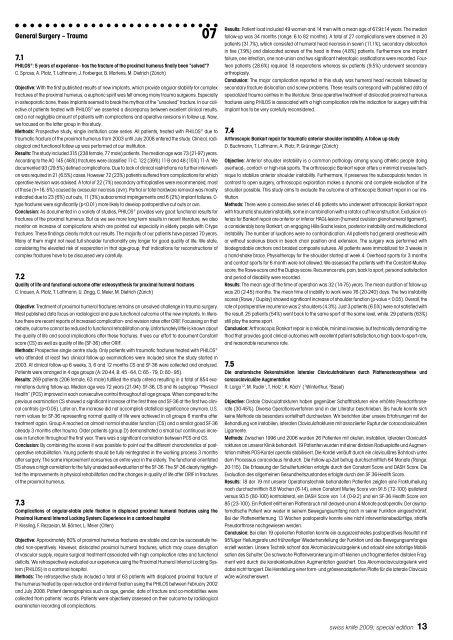Abstracts - Chirurgie Kongress
Abstracts - Chirurgie Kongress
Abstracts - Chirurgie Kongress
You also want an ePaper? Increase the reach of your titles
YUMPU automatically turns print PDFs into web optimized ePapers that Google loves.
General Surgery – Trauma 07<br />
7.1<br />
PHILOS ® : 5 years of experience - has the fracture of the proximal humerus finally been “solved”?<br />
C. Spross, A. Platz, T. Lattmann, J. Forberger, B. Martens, M. Dietrich (Zürich)<br />
Objective: With the first published results of new implants, which provide angular stability for complex<br />
fractures of the proximal humerus, a euphoric spirit was felt among many trauma surgeons. Especially<br />
in osteoporotic bone, these implants seemed to break the mythos of the “unsolved” fracture. In our collective<br />
of patients treated with PHILOS ® we asserted a discrepancy between excellent clinical results,<br />
and a not negligible amount of patients with complications and operative revisions in follow up. Now,<br />
we focused on the latter group in this study.<br />
Methods: Prospective study, single institution case series. All patients, treated with PHILOS ® due to<br />
traumatic fracture of the proximal humerus from 2003 until July 2008 entered the study. Clinical, radiological<br />
and functional follow up was performed at our institution.<br />
Results: The study included 315 (238 female, 77 male) patients. The median age was 73 (21-97) years.<br />
According to the AO 145 (46%) fractures were classified 11-C, 122 (39%) 11-B and 48 (15%) 11-A. We<br />
documented 93 (29.5%) defined complications. Due to lack of clinical restrictions no further intervention<br />
was required in 21 (6.5%) cases. However 72 (23%) patients suffered from complications for which<br />
operative revision was advised. A total of 22 (7%) secondary arthroplasties were recommended, most<br />
of those (n=16, 5%) caused by avascular necrosis (avn). Partial or total hardware removal was mostly<br />
indicated due to 23 (6%) cut outs, 11 (3%) subacromial impingements and 6 (2%) implant failures. Ctype<br />
fractures were significantly (p



